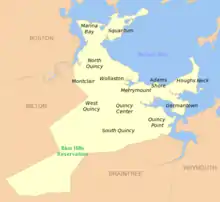Quincy Adams station
Quincy Adams is a rapid transit station in Quincy, Massachusetts. It serves the Braintree Branch of the MBTA's Red Line. Located in southern Quincy on Burgin Parkway near the Braintree Split, the station features a large park and ride garage, with space for 2,538 automobiles, built over the station tracks and platforms. It is fully accessible.
Quincy Adams | |||||||||||||
|---|---|---|---|---|---|---|---|---|---|---|---|---|---|
%252C_December_2018.JPG.webp) Quincy Adams station platform viewed from above in 2018 | |||||||||||||
| Location | Burgin Parkway at Centre Street Quincy, Massachusetts | ||||||||||||
| Coordinates | 42°13′58″N 71°00′29″W | ||||||||||||
| Line(s) | Braintree Branch (Red Line) | ||||||||||||
| Platforms | 1 island platform | ||||||||||||
| Tracks | 2 (Red Line) 1 (Commuter rail) | ||||||||||||
| Connections | |||||||||||||
| Construction | |||||||||||||
| Parking | 2538 spaces ($9.00 fee) 29 accessible spaces | ||||||||||||
| Bicycle facilities | 64 spaces | ||||||||||||
| Disabled access | Yes | ||||||||||||
| History | |||||||||||||
| Opened | September 10, 1983[1] | ||||||||||||
| Closed | June 30, 1959 | ||||||||||||
| Previous names | South Quincy (until 1867) | ||||||||||||
| Passengers | |||||||||||||
| FY2019 | 4,665 boardings (weekday average)[2] | ||||||||||||
| Services | |||||||||||||
| |||||||||||||
| |||||||||||||
History
Old Colony Railroad
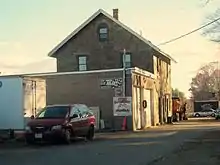
The Old Colony Railroad had a South Quincy station at Water Street in southern Quincy.[3][4] In December 1867, it was renamed Quincy Adams (after President John Quincy Adams, who was born nearby).[5] A stone station building was constructed in 1869; it was identical to the still-extant station at Avon, which was built around the same time.[6]
The 1926 Report on Improved Transportation Facilities and 1945–47 Coolidge Commission Report recommended the Cambridge–Dorchester line receive a branch to Braintree along the Old Colony right-of-way.[7][8] Quincy Adams station closed along with the rest of the Old Colony system on June 30, 1959, and was later demolished.[3][6]
Red Line opening
The MBTA received a $21 million federal grant (with $5 million local match required) in July 1976 for the construction of South Quincy station.[9] The station (renamed Quincy Adams) opened on September 10, 1983 as an infill station on the Braintree Branch. Quincy Adams had been scheduled to open along with Braintree (which opened on March 22, 1980), but construction delays caused opening to be three years late.[1] The station has been accessible since at least 1989.[10] The station ultimately cost $32 million to build.[11]
From their openings until 2007, a double entry fare and single exit fare were charged at Quincy Adams and Braintree when leaving the subway, as a proxy for distance-based fares. The extra fares was discontinued as part of a fare increase and service change on January 1, 2007.[12] Similar charges existed until 1980 for the inner stations on the Braintree Branch.
Garage issues
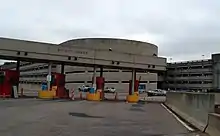
Until 2012, access to the garage had only been from ramps off I-93 and Route 3, with the Burgin Parkway entrance leading only to a 160-space surface lot. In July 2012, after the closure of the garage at Quincy Center due to structural issues, the 130-space lower level of the garage was made accessible from Burgin Parkway as well.[13]
Although built to last 50 years, the $28 million garage at Quincy Adams began suffering concrete damage due to water leakage and ill-fitting structural elements. Repairs were performed to the Quincy Adams and Braintree garages in the mid 1990s. In 2015, the MBTA began a $4.4 million project to address urgent structural issues with the two garages, though full repair or replacement was still needed.[14] The garage is being fully renovated from May 2018 through December 2021 at a cost of $35 million; the station and garage will remain open during the whole project. A separate $10.5 million project, lasting from August 2018 to October 2021, will replace three existing elevators and add a redundant platform elevator.[15][16] The garage was closed for three months beginning on October 5, 2020.[17]
Independence Avenue entrance
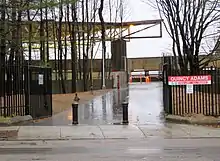
Until December 2018, the only pedestrian access to the station was via the park and ride garage off Burgin Parkway. The MBTA opened a pedestrian entrance on the east side of the station leading to Independence Avenue in 1981. However, the streets surrounding that entrance were frequently used for parking by riders seeking to avoid paying for the parking garage. In the late 1980s, the entrance was closed, leaving neighborhood residents without station access.[18][19] Some neighborhood residents climbed over the gate to use the station.[20] The entrance was a point of contention between the cities of Quincy and Braintree; in February 2014, officials from the two towns proposed that a lock system be created where only nearby residents could enter from Independence Avenue.[21]
The garage improvements included repairs to the pathway from Independence Avenue, but the MBTA claimed that the entrance was a "city issue" and did not plan to reopen it as part of the project.[22] In April 2018, the city announced that the gate would be opened by September of that year.[23] The gate was ultimately opened on December 3, 2018.[24]
Bus service
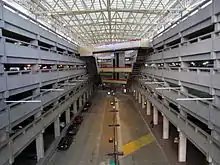
The station was built with a large busway (bus transfer facility) for MBTA bus routes, with entry from Centre Street and exit to Burgin Parkway, but it has remained very underutilized throughout the history of the station. The busway has never served as a terminal for any MBTA bus route, and only route 238 uses it.[1] (Route 230, which runs on Independence Avenue, also serves the station.) However, several other services have used the busway at various times.
In November 1985, one-week trials were run of MBTA service directly from Alewife and Quincy Adams to Logan International Airport. The Quincy Adams service was considered successful and became permanent; it was later contracted to Plymouth & Brockton in November 1987. From 1988 to 1990, service continued past Quincy Adams to Plymouth. In November 1990, the terminal was moved from Quincy Adams to a parking lot near Braintree to free garage spots for MBTA commuters.[1]
In February 1990, two special routes, 201 Riverside–Museum of Fine Arts and 202 Quincy Adams–Museum of Fine Arts, were run during a Monet exhibition at the museum.[1] Beginning in August 1999, Interstate Coach operated reverse commute bus service from Boston to a business park in Canton, with intermediate stops at JFK/UMass and Quincy Adams. The service was operated by Bloom Bus Lines after it acquired Interstate in August 2003, but discontinued in July 2004.[1]
Beginning with the 1994 season, the MBTA subsidized private-carrier service from Forest Hills, Alewife, Riverside, and Quincy Adams to Gillette Stadium for New England Patriots home games. Service from the latter three stations lasted until the 2000 season.[1]
Station layout
A single track runs through the station carrying the Old Colony Lines and Greenbush Line of the MBTA Commuter Rail system, but there is no commuter rail platform and trains do not stop.
| G | Street level | Exit/entrance, buses, parking garage |
| P Platform level |
Northbound | ← Red Line toward Alewife (Quincy Center) |
| Island platform | ||
| Southbound | Red Line toward Braintree (Terminus) → | |
| Commuter | ← MBTA Commuter Rail and CapeFLYER do not stop here → | |
| M | Mezzanine | Red Line fare control, connection between platforms |
Notes
- Belcher, Jonathan. "Changes to Transit Service in the MBTA district" (PDF). NETransit.
- "A Guide to Ridership Data". MassDOT/MBTA Office of Performance Management and Innovation. June 22, 2020. p. 9.
- Karr, Ronald Dale (1995). The Rail Lines of Southern New England. Branch Line Press. pp. 310–315. ISBN 0942147022.
- "Quincy 1876: Southern Section". Atlas of Norfolk County. Comstock & Cline. 1876. Retrieved 25 July 2014.
- Jacobs, Warren (October 1928). "Dates of Some of the Principal Events in the History of 100 Years of the Railroad in New England. 1826-1926". Railway and Locomotive Historical Society Bulletin. Railway and Locomotive Historical Society. 17: 15–28. JSTOR 43504499.
- Roy, John H. Jr. (2007). A Field Guide to Southern New England Railroad Depots and Freight Houses. Branch Line Press. p. 128. ISBN 9780942147087.
- Central Transportation Planning Staff (15 November 1993). "The Transportation Plan for the Boston Region – Volume 2". National Transportation Library. Retrieved 25 July 2014.
- Boston Elevated Railway and Boston Department of Public Utilities (1945), Boston Rapid Transit System & Proposed Extensions 1945 – Metropolitan Transit Recess Commission Air View
- Wermiel, Stephen; Jordan, Robert (July 21, 1976). "MBTA to get $60m from US". Boston Globe – via Newspapers.com.

- Tran Systems and Planners Collaborative (August 24, 2007). "Evaluation of MBTA Paratransit and Accessible Fixed Route Transit Services: Final Report" (PDF). Massachusetts Bay Transportation Authority.
- Crocket, Douglas S. (September 4, 1983). "As projects end, some changes in T". Boston Globe. p. 23 – via Newspapers.com.

- Waltz, Vicky (November 11, 2006). "End of the Line for Free T". BU Today. Retrieved 1 July 2012.
- Simpson, Neal (18 July 2012). "MBTA to open Burgin Parkway entrance to Quincy Adams garage". Patriot Ledger. Retrieved 14 May 2015.
- Burrell, Chris (16 November 2015). "Stopgap repairs being made to crumbling MBTA garages in Quincy, Braintree". Patriot Ledger. Retrieved 24 February 2016.
- "MBTA Contract No. W46CN04: South Shore Parking Garage Repairs" (PDF). Massachusetts Bay Transportation Authority. August 6, 2018.
- Brelsford, Laura (May 26, 2020). "SWA Initiatives – May 2020" (PDF). Massachusetts Bay Transportation Authority. pp. 11–12.
- "South Shore Garages". Massachusetts Bay Transportation Authority. September 28, 2020. Archived from the original on September 29, 2020.
- Tan, L. Kim (7 December 2006). "Can't get there from here". Boston Globe. Retrieved 12 April 2011.
- Davey, Rich (22 May 2011). "Ask the MBTA: On gates and delays". Metro. Retrieved 1 July 2012.
- Hanson, Fred (21 October 2015). "Opinions remain split on Quincy Adams station access". Patriot Ledger. Retrieved 3 January 2016.
- Simpson, Neal (14 February 2014). "Plan targets entrance dispute at Quincy Adams T station". Patriot Ledger. Retrieved 25 July 2014.
- Hanson, Fred (April 12, 2017). "Quincy Adams station work doesn't include gate opening". Wicked Local Somerville. Retrieved April 15, 2017.
- Cotter, Sean Philip (April 25, 2018). "City to open controversial Quincy Adams pedestrian gate". Patriot Ledger.
- Vaccaro, Adam (December 3, 2018). "Finally, gate opens to connect Red Line and Quincy neighborhood". Boston Globe.
External links
| Wikimedia Commons has media related to Quincy Adams station. |
